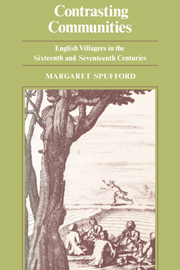Book contents
- Frontmatter
- Contents
- List of maps and graphs
- List of tables
- List of abbreviations
- Acknowledgements
- Dedication
- Introduction
- Map 1 Cambridgeshire: natural boundaries and soil types
- Map 2 Cambridgeshire: county and parish boundaries
- PART 1 People, Families and Land
- PART 2 The Schooling of the Peasantry
- PART 3 Parishioners and their Religion
- Conclusion
- Appendix 1 The Butlers of Orwell
- Appendix 2 Notes on Graphs 3 and 5
- Index of Contemporary Names
- General Index
Appendix 2 - Notes on Graphs 3 and 5
Published online by Cambridge University Press: 25 January 2010
- Frontmatter
- Contents
- List of maps and graphs
- List of tables
- List of abbreviations
- Acknowledgements
- Dedication
- Introduction
- Map 1 Cambridgeshire: natural boundaries and soil types
- Map 2 Cambridgeshire: county and parish boundaries
- PART 1 People, Families and Land
- PART 2 The Schooling of the Peasantry
- PART 3 Parishioners and their Religion
- Conclusion
- Appendix 1 The Butlers of Orwell
- Appendix 2 Notes on Graphs 3 and 5
- Index of Contemporary Names
- General Index
Summary
The harvest years and data on grain used in Graph 3, p. 79, are those used by Dr Bowden, in the Agrarian History of England and Wales, iv, 818–20. The barley price series used is the Cambridge one, and so should be a reliable guide to Chippenham conditions. The rye series, where it exists, is that from Loder's account book. Dr Bowden's ‘harvest’ year is in fact the accounting year, and runs from 29 September one calendar year, until 28 September the next. This year, however, reflects the quality and abundance of the harvest already in the barns on 29 September, not that of the one sown and actually harvested during it. The courts at Chippenham were usually held yearly, in late September or early October. This presumably meant that the day of the court was rent-day, and the time was carefully chosen to fall after harvest, when the tenants were in a position to pay their rent after selling some of their crops. At this annual court, all the deaths and sales since the previous one were, supposedly, reported.
This court always just falls within the beginning of the harvest (that is, accounting) year. It must, however, reflect the (court) dealings which took place over the whole of the previous year.
- Type
- Chapter
- Information
- Contrasting CommunitiesEnglish Villages in the Sixteenth and Seventeenth Centuries, pp. 356 - 357Publisher: Cambridge University PressPrint publication year: 1974



